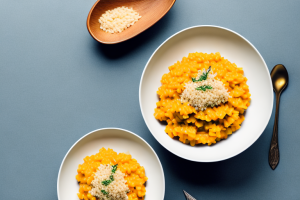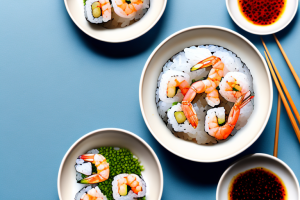How to cook jasmine rice with coconut milk
9 min read
A pot of jasmine rice cooking in coconut milk
Jasmine rice with coconut milk is a delightful Southeast Asian dish that is popular across the world. It is a classic recipe that combines the delicate fragrances of jasmine rice with the rich, creamy sweetness of coconut milk. If you’re looking to master this dish at home, then read on – we’ve got everything you need to know.
A step-by-step guide to making the perfect jasmine rice with coconut milk
The first step to making the perfect jasmine rice with coconut milk is selecting the right ingredients. For this recipe, you’ll need high-quality jasmine rice, coconut milk, and some water. Rinse the rice thoroughly before cooking to remove any excess starch. This will help give you fluffy, perfectly cooked rice.
Next, combine the rice, coconut milk, and water in a pot and bring it to a boil. Reduce the heat and let it simmer gently for 20-25 minutes while covered until the rice is fully cooked and the liquid has been absorbed. Make sure to fluff the rice up with a fork before serving, so it stays nice and light.
For an extra burst of flavor, you can add some spices to the rice while it’s cooking. Cinnamon, cardamom, and cloves are all great options that pair well with the coconut milk. Simply add a pinch of your chosen spice to the pot before bringing it to a boil.
If you’re looking to make this dish even healthier, you can swap out the white jasmine rice for brown jasmine rice. Brown rice is a whole grain and contains more fiber and nutrients than white rice. It will take a bit longer to cook, so adjust the cooking time accordingly.
The health benefits of using coconut milk in your rice dishes
Coconut milk is a popular ingredient in many Southeast Asian kitchens, and it has a range of health benefits such as being an excellent source of healthy fats. Research suggests that coconut milk can reduce bad cholesterol and improve heart health. Furthermore, it also contains vitamins, minerals, and antioxidants that are essential for your health.
In addition to its heart-healthy benefits, coconut milk is also known to have anti-inflammatory properties. This means that it can help reduce inflammation in the body, which is linked to a range of chronic diseases such as arthritis, diabetes, and cancer. Coconut milk also contains lauric acid, which has been shown to have antimicrobial properties that can help fight off harmful bacteria and viruses.
Another benefit of using coconut milk in your rice dishes is that it can help you feel fuller for longer. This is because the healthy fats in coconut milk are digested slowly, which means that they provide a sustained source of energy. This can be particularly beneficial for people who are trying to lose weight or maintain a healthy weight.
Tips for selecting the best quality jasmine rice for your recipe
Choosing the right type of jasmine rice is crucial to making a perfect dish. If you’re unsure, look for high-quality long-grain jasmine rice that has a slightly sweet and aromatic flavor. Check the packaging for any instructions on how to prepare the rice. In some cases, the rice may need to soak in water before cooking.
Another important factor to consider when selecting jasmine rice is the age of the rice. Fresher rice will have a better texture and flavor. Look for rice that has been harvested within the last year. You can also check the packaging for the harvest date or expiration date to ensure that you are getting fresh rice.
It’s also important to consider the origin of the jasmine rice. Thai jasmine rice is considered to be the best quality and is often used in traditional Thai dishes. However, there are also high-quality jasmine rice varieties from other countries such as Vietnam and Cambodia. Consider trying different varieties to find the one that best suits your taste and recipe.
How to prepare your rice and coconut milk before cooking
Before cooking, rinse the jasmine rice thoroughly to remove any impurities, then drain it in a colander. In a separate bowl, mix coconut milk with water. The typical ratio is 2:1, with two cups of liquid for every cup of rice. If you prefer a more coconutty flavor, you can adjust this ratio.
It is important to note that the quality of the coconut milk can greatly affect the taste of your dish. If possible, opt for fresh coconut milk or high-quality canned coconut milk. Lower quality coconut milk may result in a less flavorful dish.
Additionally, if you want to add some extra flavor to your rice, you can consider adding some spices or herbs to the coconut milk mixture. Popular options include ginger, lemongrass, and pandan leaves. Simply add the desired spices to the coconut milk and water mixture and let it infuse for a few minutes before using it to cook the rice.
Variations on the classic jasmine rice with coconut milk recipe
While the traditional jasmine rice with coconut milk recipe is delicious, there are also many variations you can try. For example, you could add ginger or lemongrass to the mix while cooking to give it a bit of extra kick. You can also add fresh vegetables, such as diced carrots or green beans, for extra color and nutrition.
Another variation you can try is to use different types of rice, such as brown or black rice, instead of the traditional jasmine rice. This will add a nuttier flavor and a chewier texture to the dish. You can also experiment with different types of coconut milk, such as light or full-fat, to see which one you prefer.
If you want to make the dish more filling, you can add protein sources such as tofu, chicken, or shrimp. Simply cook the protein separately and add it to the rice and coconut milk mixture towards the end of the cooking process. This will give the dish a more complete and balanced nutritional profile.
Serving suggestions for your delicious and aromatic dish
Jasmine rice with coconut milk is a versatile dish that can be served with a range of dishes. It pairs perfectly with curries, stir-fries, and grilled meats. You can also serve it with some roasted vegetables or a side salad for a healthy and colorful meal.
If you want to add some extra flavor to your dish, you can try adding some chopped herbs such as cilantro or basil to the rice before serving. This will give it a fresh and fragrant taste that will complement the coconut milk and spices. Another option is to top the rice with some toasted coconut flakes or chopped nuts for a crunchy texture. Whatever way you choose to serve it, this dish is sure to be a crowd-pleaser!
How to store and reheat leftover jasmine rice with coconut milk
If you have leftovers, store them in an airtight container in the fridge for up to three days. To reheat, add a splash of water or coconut milk to the rice to prevent it from drying out, and microwave it or gently heat it on the stove until it’s hot.
It’s important to note that reheating rice can be risky if not done properly. Make sure to heat the rice to an internal temperature of at least 165°F to kill any potential bacteria. Additionally, if the rice has been sitting out at room temperature for more than two hours, it’s best to discard it rather than risk food poisoning.
The history and cultural significance of this popular Southeast Asian dish
Jasmine rice with coconut milk is a traditional dish that is enjoyed across Southeast Asia. It is often served during special occasions and festivals. In Thailand, where the dish is known as “khao tom mat,” it is believed to have originated in the royal court. Today, it is a staple in many Thai households.
Aside from its delicious taste, jasmine rice with coconut milk also holds cultural significance in Southeast Asia. In many countries, the dish is associated with prosperity and good luck. It is often served during weddings and other important celebrations as a symbol of abundance and happiness. Additionally, the use of coconut milk in the dish is a nod to the region’s abundant coconut trees and the importance of coconut in Southeast Asian cuisine.
Common mistakes to avoid when cooking jasmine rice with coconut milk
One of the most common mistakes when cooking jasmine rice with coconut milk is not measuring the ingredients correctly. Not using the right amount of liquid can lead to rice that is either too dry or too wet. Make sure you follow the recipe closely to get perfectly cooked rice every time.
Another mistake to avoid is not rinsing the rice before cooking. Rinsing removes excess starch and prevents the rice from becoming too sticky. Rinse the rice until the water runs clear before adding it to the pot.
It’s also important to not lift the lid of the pot while the rice is cooking. This can release steam and disrupt the cooking process, resulting in unevenly cooked rice. Trust the recipe and let the rice cook undisturbed until it’s done.
Frequently asked questions about cooking with jasmine rice and coconut milk
Some of the most frequently asked questions about cooking with jasmine rice and coconut milk include how much liquid to use, how long to cook the rice, and what spices to use. Remember that the recipe and cooking times may vary depending on the type of rice you’re using, so it’s always best to read and follow the label instructions.
Another common question is whether to rinse the rice before cooking. It’s recommended to rinse jasmine rice before cooking to remove excess starch and improve the texture. However, some people prefer not to rinse the rice to preserve its natural fragrance.
Additionally, if you’re using canned coconut milk, make sure to shake the can well before opening to ensure the cream and liquid are well combined. You can also adjust the amount of coconut milk used depending on your preference for a creamier or lighter texture.
Vegan and gluten-free options for this flavorful recipe
If you’re vegan or gluten-free, you’ll be happy to know that jasmine rice with coconut milk is a dish that can easily be adapted to suit your dietary requirements. Simply ensure that you’re using gluten-free rice, and look for coconut milk that is free from any animal-derived ingredients.
Additionally, you can also add some vegetables to this dish to make it even more nutritious. Some great options include diced bell peppers, sliced carrots, and chopped broccoli. Simply sauté the vegetables in a separate pan and add them to the rice and coconut milk mixture before serving.
How to modify the recipe to suit your personal taste preferences
Jasmine rice with coconut milk is a versatile dish that you can modify to suit your taste preferences. You could use different herbs and spices for a more complex flavor, or adjust the ratios of rice to liquid for a particular texture. Feel free to experiment, and have fun with this recipe!
If you prefer a sweeter taste, you can add a tablespoon of honey or maple syrup to the recipe. Alternatively, if you prefer a savory taste, you can add a pinch of salt or soy sauce to the dish.
If you want to make this dish more filling, you can add some protein such as chicken, shrimp, or tofu. Simply cook the protein separately and add it to the rice and coconut milk mixture towards the end of the cooking process.
Nutrition facts and calorie count for a serving of jasmine rice with coconut milk
A serving of jasmine rice with coconut milk is a reasonably healthy dish that is high in carbohydrates and healthy fats. It is also rich in fiber, vitamins, and minerals. However, the calorie count can vary depending on the specific ingredients and serving size. On average, a serving of jasmine rice with coconut milk contains around 350-400 calories.


